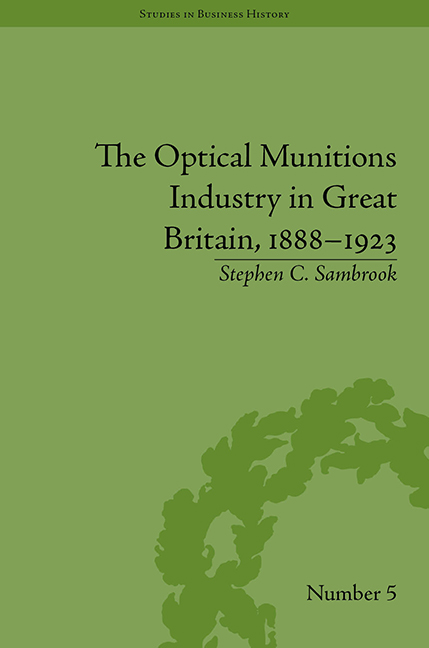Book contents
- Frontmatter
- CONTENTS
- Preface and Acknowledgements
- List of Figures and Tables
- List of Technical Terms
- Introduction
- 1 The Emergence of the Industry, 1888–99
- 2 The Growth in Importance from the Boer War to 1906
- 3 Expansion and Consolidation, 1907–14
- 4 The Impact of War, August 1914 to mid-1915
- 5 Industrial Mobilization: The Ministry of Munitions and its Relationship with the Industry
- 6 The Industry's Wartime, 1915–18
- 7 Industrial Demobilization and Implosion, 1919
- 8 Adaption and Survival, 1919–23
- Conclusion
- Notes
- Works Cited
- Index
Conclusion
- Frontmatter
- CONTENTS
- Preface and Acknowledgements
- List of Figures and Tables
- List of Technical Terms
- Introduction
- 1 The Emergence of the Industry, 1888–99
- 2 The Growth in Importance from the Boer War to 1906
- 3 Expansion and Consolidation, 1907–14
- 4 The Impact of War, August 1914 to mid-1915
- 5 Industrial Mobilization: The Ministry of Munitions and its Relationship with the Industry
- 6 The Industry's Wartime, 1915–18
- 7 Industrial Demobilization and Implosion, 1919
- 8 Adaption and Survival, 1919–23
- Conclusion
- Notes
- Works Cited
- Index
Summary
The story of optical munitions manufacture in Britain between 1888 and 1923 has shown the evolution of a peculiar, even idiosyncratic industry whose progress was often as much governed by the state's defence policies as by its technical and commercial abilities. Although sharing many of the characteristics of the optical instruments industry, such as the computation of lens systems and the finest standards of mechanical engineering, its evolution is best understood by seeing it in the perspective of the armaments industry which provided the stimulus for the creation of almost all of its products. The crucial division between civil instrument and munitions manufacture lay not just in the nature of the products but in the nature of their clients. Armies and navies, and their exchequers, were very different to surveyors, scientists and the man in the street requiring disparate marketing methods. But despite its differences, the optical munitions sector still drew on the private sector for many of its optical techniques, raw materials and skilled workers.
The British optical munitions makers functioned in a demand-led market which was driven by evolving weapons technologies and often heavily influenced by social factors exerted by those who formulated and influenced thinking within the armed forces. The War Office's protracted indecision in choosing an artillery rangefinder between the end of the Boer War and 1914 was caused at first by the service's adherence to the concept that the greatest potential accuracy in an instrument should take precedence over the need for speed and convenience of operation.
- Type
- Chapter
- Information
- The Optical Munitions Industry in Great Britain, 1888–1923 , pp. 205 - 212Publisher: Pickering & ChattoFirst published in: 2014



